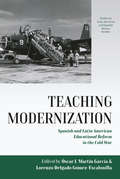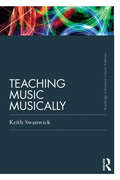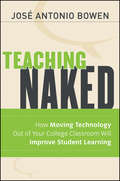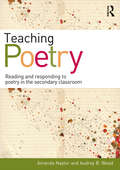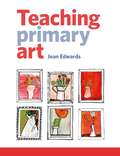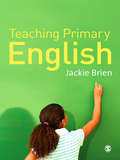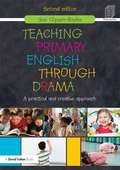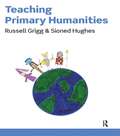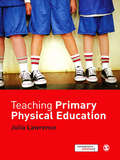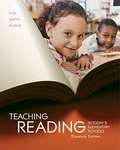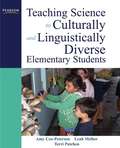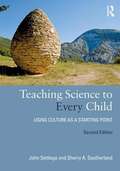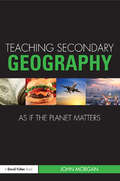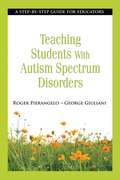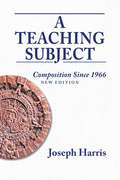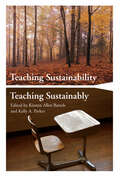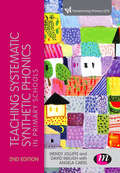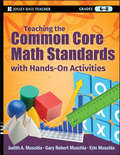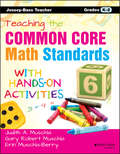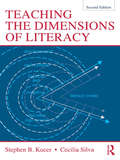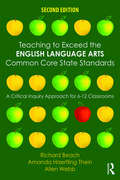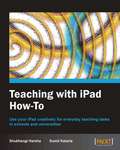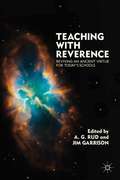- Table View
- List View
Teaching Modernization: Spanish and Latin American Educational Reform in the Cold War (Studies in Latin American and Spanish History #6)
by Óscar J. Martín García Lorenzo Delgado Gómez-EscalonillaIn the 1960s and 1970s, the educational systems in Spain and Latin America underwent comprehensive and ambitious reforms that took place amid a "revolution of expectations" arising from decolonization, global student protests, and the antagonism between capitalist and communist models of development. Deploying new archival research and innovative perspectives, the contributions to this volume examine the influence of transnational forces during the cultural Cold War. They shed new light on the roles played by the United States, non-state actors, international organizations and theories of modernization and human capital in educational reform efforts in the developing Hispanic world.
Teaching Music Musically (Classic Edition)
by Keith Swanwick'There are countless gems within these pages ... Swanwick seems to write from more experience as a musician and teacher than most others who write for this audience. There is a real sense of his having been there. - Patricia Shehan Campbell, Professor of Music, University of Washington, USA'... contains the essential and highly valued hallmark of
Teaching Naked
by José Antonio BowenYou've heard about "flipping your classroom"--now find out how to do it! Introducing a new way to think about higher education, learning, and technology that prioritizes the benefits of the human dimension. José Bowen recognizes that technology is profoundly changing education and that if students are going to continue to pay enormous sums for campus classes, colleges will need to provide more than what can be found online and maximize "naked" face-to-face contact with faculty. Here, he illustrates how technology is most powerfully used outside the classroom, and, when used effectively, how it can ensure that students arrive to class more prepared for meaningful interaction with faculty. Bowen offers practical advice for faculty and administrators on how to engage students with new technology while restructuring classes into more active learning environments.
Teaching Poetry: Reading and responding to poetry in the secondary classroom
by Amanda Naylor Audrey B. WoodTeaching Poetry is an indispensible source of guidance, confidence and ideas for all those new to the secondary English classroom. Written by experienced teachers who have worked with the many secondary pupils who ‘don’t get’ poetry, this friendly guide will help you support pupils as they access, understand, discuss and enjoy classic and contemporary poetry. With an emphasis on active approaches and the power of poetry to enrich the lives of both teachers and students, Teaching Poetry: Provides a succinct introduction to the major ideas and theory about teaching poetry Covers the key genres and periods through tried and tested favourites and a range of less well known new and historical poetry Illustrates good practice for every approach covered, through case studies of theory and ideas in action in the classroom Includes activities, ideas and resources to support teaching at Key Stages 3, 4 and 5. Teaching Poetry tackles head on one of the aspects of English teaching that new and experienced teachers alike find most difficult. It offers both a comprehensive introduction to teaching poetry and a rich source of inspiration and support to be mined when faced with an unfamiliar text or an unresponsive class.
Teaching Primary Art
by Jean EdwardsTeaching Primary Art is an introductory textbook for those training to teach and support learning in art in the primary school. The book first explores the underpinning philosophy and pedagogy of teaching and learning art, including why we teach it; planning and assessment; and teaching and support strategies. Then it covers the practical aspects of teaching art, including a list of useful vocabulary to encourage talk around art and links to cross-curricular learning.
Teaching Primary English
by Jackie BrienShortlisted for the UKLA Academic Book Award 2013! Literacy empowers learning across the whole curriculum and language is at the centre of all learning in primary education. Aware of current curriculum developments and drawing from the latest research Teaching Primary English encourages teacher education students to develop a deeper understanding of the essential issues involved in teaching English in order to approach a career in the primary classroom with the confidence and knowledge required to succeed. Taking a fresh approach to the main elements of teaching primary English, Jackie Brien strikes an engaging balance between the practical requirements of English teaching and encouraging informed reflection on key aspects of primary literacy. This is essential reading for everyone studying primary English on primary initial teacher education courses including undergraduate (BEd, BA with QTS), postgraduate (PGCE, SCITT), and employment-based routes into teaching. Jackie Brien is Curriculum Leader for English, Communication, Language and Literacy at the University of Chester.
Teaching Primary English through Drama: A practical and creative Approach
by Suzi Clipson-Boyles"The text is extraordinarily succinct, very well organised and highly readable. Each chapter examines in depth specific aspects of teaching and learning in drama and well-chosen practical examples can readily be adopted by teachers. A 'must' for all primary schools." Drama (the Journal of National Drama) Review of ‘Drama in Primary English teaching’ Teaching Primary English through Drama builds on the success of the classic text Drama in Primary English, inspiring ideas and techniques for teaching English skills through the medium of drama. Focusing on the power of drama to promote effective learning in primary education, Suzi Clipson-Boyles demonstrates how reading, writing, speaking and listening skills may be developed in ways that will motivate and engage pupils. She uses specific examples from the English curriculum, and also makes links to other areas of the curriculum. In addition, the book explains how assessment during drama can help teachers to evaluate pupils’ progress in English. Further guidance is given on how drama can enrich studying for pupils who are learning English as a foreign language. The book also provides a chapter on developing drama as an art form in its own right, with simple ideas and practical suggestions on how to enhance performances. Teaching Primary English through Drama presents a wide range of drama approaches from ten-minute starter activities to stimulate ideas such as fun ways to practise reading, through to longer projects that can provide contexts for extended writing or help with presentation and performance. The chapters show how drama can help to bring lessons alive in imaginative ways that not only promote enjoyment but also enhance achievement. This comprehensive and practical guide offers essential reading for primary teachers and other practitioners, and is a valuable resource to trainees. It also provides an excellent foundation for those who wish to extend their expertise further towards drama as a subject specialism.
Teaching Primary Humanities
by Russell GriggAs primary subjects are increasingly being taught on an interdisciplinary level, Russell Grigg and Sioned Hughes have created an innovative new text, Teaching Primary Humanities. This new text explores current debate, encourages reflection and provides clear guidance on planning, teaching and assessing the humanities from the Early Years to Key Stage 2. Through a blend of theory and real-life examples, Grigg and Hughes demonstrate the contribution that history, geography and religious education can make to enhancing children’s thinking, literacy, numeracy and ICT skills.Whether you are a trainee or a practitioner, this book will develop your knowledge of how young children’s understanding of place, time and community can be fostered through a play-based curriculum. It will also benefit teachers of older children looking to encourage more independent learning in their schools.About the authors:Dr Russell Grigg is Head of the South West Wales Centre of Teacher Education. He is a trained primary inspector for England and Wales. He has written widely in the field of history and primary education including Wales in the Victorian Age and Becoming an Outstanding Primary Teacher. Dr Sioned Hughes is Senior Lecturer in Initial Teacher Training at the South West Wales Centre of Teacher Education. She has published many educational materials, especially in primary geography. Her work on Patagonia was recognised by the Welsh Books Council as the ‘Bestselling Children’s Book’ in 2011.
Teaching Primary Physical Education
by Dr Julia Lawrence'Trainee teachers will welcome the concise and reader-friendly format this book offers. Julia Lawrence has taken great care to provide a balanced and relevant overview of the major topics trainee teachers often lack confidence in, when planning and delivering lessons. A particularly useful and welcome feature for trainee teachers is the book's companion website with helpful links to teaching resources. This book provides essential reading for all trainee primary teachers.' Nigel Clarke, Senior Lecturer in Physical Education, University of Cumbria. Physical Education is an important part of the primary curriculum and one that provides unique challenges for those involved with its teaching. Teaching Primary Physical Education provides a concise overview of the knowledge, skills and understanding required for the confident teaching of physical education in primary schools. This book offers a balanced and comprehensive overview of the subject, covering issues such as safe practice in PE, inclusion, subject leadership and cross-curricular approaches to physical education supported by an accessible theory-informed approach. Teaching Primary Physical Education is supported by a companion website www.sagepub.co.uk/lawrence, which includes further practical examples of applications, links to relevant literature and teaching resources, offering further student-friendly material for use across different physical disciplines. This is essential reading for all students studying primary physical education on primary initial teacher education courses including undergraduate (BEd, BA with QTS), postgraduate (PGCE, SCITT), and employment-based routes into teaching, and also for those on Sports Studies courses with a Primary PE component. Dr Julia Lawrence is Subject Leader of Physical Education at Leeds Metropolitan University.
Teaching Reading in Today's Elementary Schools Eleventh Edition
by Betty D. Roe Sandy H. SmithThis market-leading text sets the standard for reading instruction to ensure that aspiring teachers are able to help students learn not only how to recognize words, but also how to comprehend what they read--and enjoy the process. The book balances new approaches to reading, such as language arts integration and emergent literacy/literacy as a continuum, with more traditional foundations of strong skills and phonics instruction. Updates to the Eleventh Edition include discussion of the latest technology for literacy learning, how writing instruction impacts literacy learning, and recent movements in literacy assessment.
Teaching Science to Culturally and Linguistically Diverse Elementary Students
by Amy Cox-Petersen Leah Melber Terri R. PatchenTeaching Science to Culturally and Linguistically Diverse Elementary Students helps K-8 teachers implement culturally relevant instructional strategies to ensure that all students, regardless of race, ethnicity, or socioeconomic class, can do science, like science, and become scientists if they choose. In America's increasingly diverse classrooms, science is not always presented in a way that is meaningful to all students. With this in mind, this book outlines 8 culturally relevant strategies for teaching science to help ensure all students have access to inquiry-based, interactive, and experiential science learning. Written to encourage inclusive practices, the book shows how to teach science using students' experiences, how to integrate science and literacy and how to use alternative methods to assess students' understanding of science. Includes 8 culturally relevant strategies for teaching science to all students-outlines inclusive practices that ensure all students have access to inquiry-based, interactive, and experiential science learning. Emphasizes family connections and teaching science to and through students' experiences-connects science activities and content to students' lives at home and includes a chapter on fostering family connections and family connections icons throughout the book. Offers examples of science and literacy connections-models how teachers can integrate science and literacy to enhance students' understanding of science. Includes case studies with reflection questions in each chapter-provides examples of culturally relevant science teaching in the K-8 classroom for teachers to analyze and discuss. Offers step-by-step descriptions of four science instructional models,including Concept Attainment, Concept Formation, Group Investigation and 5 Es Model. Devotes a complete chapter to alternative assessment with diverse learners-provides a variety of examples and assessment methods to help teachers gauge students' understanding of science. Presents book study questions-helps teachers discuss the book professionally and apply the information to their current science activities.
Teaching Science to Every Child: Using Culture as a Starting Point
by Sherry Southerland John SettlageProviding timely and practical guidance about teaching science to all students, this text gives particular emphasis to making science accessible to populations who are typically pushed to the fringe - especially students of color and English language learners. Central to this text is the idea that science can be viewed as a culture, including specific methods of thinking, particular ways of communicating, and specialized kinds of tools. By using culture as a starting point and connecting it to effective instructional approaches, this text gives elementary and middle school science teachers a valuable framework to support the science learning of every student. Changes in the Second Edition: Three new chapters; technological tools and resources embedded throughout each chapter; increased attention to the role of theory as it relates to science teaching and learning; expanded use of science process skills; updated and expanded Companion Website (www.routledge.com/textbooks/9780415892582).
Teaching Secondary Geography as if the Planet Matters (Teaching... as if the Planet Matters)
by John Morgan'Teaching Geography as if the Planet Matters provides a timely outline of powerful knowledge and arguments that will be needed to counter a strengthening of current curriculum orthodoxies. Not until school geography undergoes the revolution that this book outlines can it honestly claim to be contributing to more sustainable futures.' - John Huckle, Visiting Fellow at the University of York and was formerly Principal Lecturer in Educaton at De Montfort University. We are surrounded by images and warnings of impending environmental disaster. Climate change, famine, population growth and urban crisis coupled with more recent financial chaos all threaten our sense of what it will be like to live in the future. This thought-provoking text looks at how Geography teachers can develop approaches to curriculum and learning which help students understand the nature of the contemporary world. It sets out a model for teaching and learning that allows teachers to examine existing approaches to teaching and draw upon the insights of geography as a discipline to deepen students’ understanding of urban futures, climate change, ‘geographies of food’ and the ‘geographies of the credit crunch’. Features include: examples of suggested teaching activities questions and activities for further study detailed case studies sources of further reading and information The true worth of a school subject is revealed in how far it can account for and respond to the major issues of the time. The issue of the environment cuts across subject boundaries and requires an interdisciplinary response. Geography teachers are part of that response and they have a crucial role in helping students to respond to environmental issues and representations.
Teaching Students with Autism Spectrum Disorders: A Step-by-Step Guide for Educators
by George Giuliani Roger PierangeloWritten by experts in special education and psychology, this user-friendly resource summarizes current research and presents a comprehensive overview of how to teach students with autism spectrum disorders (ASD). The authors discuss intervention strategies for implementing effective educational programs that give youngsters with ASD the opportunity to learn and interact with their peers.This practical book describes the characteristics of specific disorders, including autistic disorder, childhood disintegrative disorder, pervasive developmental disorder not otherwise specified, Rett syndrome, and Asperger syndrome. Other topics include:Overview of effective interventions Creating quality educational programs and collaborating with parents Strategies for classroom management, communication development, and social skills Characteristics, learning styles, and intervention strategiesBehavior and discipline issuesFacilitating inclusionSpecific instructional approachesBehavioral, skill-based, and physiologically based intervention modelsAssistive technology optionsSupport services for transition from high school to adult life Teaching Students with Autism Spectrum Disorders addresses the most significant, everyday challenges that general and special education teachers face in reaching students with ASD.
Teaching Subject, A: Composition Since 1966, New Edition (G - Reference,information And Interdisciplinary Subjects Ser.)
by Joseph HarrisIn this classic text, Joseph Harris traces the evolution of college writing instruction since the Dartmouth Seminar of 1966. A Teaching Subject offers a brilliant interpretive history of the first decades during which writing studies came to be imagined as a discipline separable from its partners in English studies. Postscripts to each chapter in this new edition bring the history of composition up to the present. Reviewing the development of the field through five key ideas, Harris unfolds a set of issues and tensions that continue to shape the teaching of writing today. Ultimately, he builds a case, now deeply influential in its own right, that composition defines itself through its interest and investment in the literacy work that students and teachers do together. Unique among English studies fields, composition is, Harris contends, a teaching subject.
Teaching Sustainability / Teaching Sustainably
by Kirsten Allen Bartels Kelly A. ParkerOver the coming decades, every academic discipline will have to respond to the paradigm of more sustainable life practices because students will be living in a world challenged by competition for resources and climate change, and will demand that every academic discipline demonstrate substantial and corresponding relevance.This book takes as its point of departure that integrating a component of sustainability into a discipline-specific course arises from an educator asking a simple question: in the coming decades, as humanity faces unprecedented challenges, what can my discipline or area of research contribute toward a better understanding of these issues? The discipline need not be future-oriented: an archaeologist, for instance, could incorporate into a course some aspects of sustainable archaeological practices in areas threatened by rapid climate change, as well as examples of sustainable or unsustainable ways of living practiced by members of the long-gone society under investigation. This book also argues that courses about sustainability need to cross disciplinary boundaries, both because of the inter-relatedness of the issues, and because students will require the ability to use interdisciplinary approaches to thrive through the multiple careers most of them will face.The contributions to this book are presented under four sections. “Sustainability as a Core Value in Education” considers the rationale for incorporating sustainability in disciplinary courses. “Teaching Sustainability in the Academic Disciplines” presents eight examples of courses from disciplines as varied as agriculture, composition, engineering, and teacher education. “Education as a Sustainable Practice” reviews how the physical environment of the classroom and the delivery of instruction need themselves to reflect the values being taught. The final section addresses the issues of leadership and long-term institutional change needed to embed sustainable practice as a core value on campus.
Teaching Systematic Synthetic Phonics in Primary Schools (Transforming Primary QTS Series)
by David Waugh Angela Carss Wendy JolliffeThe government prioritizes systematic synthetic phonics as a key strategy in the teaching of reading and this text supports trainee teachers working towards primary QTS in how to use phonics effectively. The text begins by examining the central role of phonics in the teaching of reading, drawing on recent research and initiatives. It goes on to cover the essential knowledge trainees need to acquire themselves for the teaching of phonics to children. Accessible and relevant, the text uses case studies and useful research to support trainees in becoming competent and confident in the teaching of phonics. Supplement this text with the companion audit and test book: Teaching Systematic Synthetic Phonics Audit and Test About the Transforming Primary QTS series This series reflects the new creative way schools are begining to teach, taking a fresh approach to supporting trainees as they work towards primary QTS. Titles provide fully up to date resources focused on teaching a more integrated and inclusive curriculum, and texts draw out meaningful and explicit cross curricular links.
Teaching the Arts
by Amy Hamilton David Roy William BakerTeaching the Arts: Early Childhood and Primary Education provides a comprehensive and exciting introduction to Arts education in Australia and New Zealand. By illustrating the fundamental links between theory and practice, this book equips students with the skills and knowledge to teach the Arts. The book covers each of the five Arts strands -dance, drama, media arts, music and visual arts - in detail. Each chapter encourages readers to engage with the Arts and provides opportunities to develop understanding and practical skills through reflective questions, examples and activities. Teaching the Arts draws important links to the Australian Curriculum, the New Zealand Curriculum, the Early Years Learning Framework and TeWhariki, and includes substantial references to Indigenous histories and cultures, relationships with Asia, and sustainability. Generously illustrated and featuring excellent on-line resources, Teaching the Arts is an indispensable resource for pre-service teachers.
Teaching the Common Core Math Standards with Hands-On Activities, Grades 6-8
by Judith A. Muschla Gary Robert Muschla Erin MuschlaHelpful advice for teaching Common Core Math Standards to middle-school students The new Common Core State Standards for Mathematics have been formulated to provide students with instruction that will help them acquire a thorough knowledge of math at their grade level, which will in turn enable them to move on to higher mathematics with competence and confidence. Hands-on Activities for Teaching the Common Core Math Standards is designed to help teachers instruct their students so that they will better understand and apply the skills outlined in the Standards. This important resource also gives teachers a wealth of tools and activities that can encourage students to think critically, use mathematical reasoning, and employ various problem-solving strategies. Filled with activities that will help students gain an understanding of math concepts and skills correlated to the Common Core State Math Standards Offers guidance for helping students apply their understanding of math concepts and skills, develop proficiency in calculations, and learn to think abstractly Describes ways to get students to collaborate with other students, utilize technology, communicate ideas about math both orally and in writing, and gain an appreciation of the significance of mathematics to real life This practical and easy-to-use resource will help teachers give students the foundation they need for success in higher mathematics.
Teaching the Common Core Math Standards with Hands-On Activities, Grades 6-8
by Gary Robert Muschla Erin Muschla Judith A. MuschlaHelpful advice for teaching Common Core Math Standards to middle-school studentsThe new Common Core State Standards for Mathematics have been formulated to provide students with instruction that will help them acquire a thorough knowledge of math at their grade level, which will in turn enable them to move on to higher mathematics with competence and confidence. Hands-on Activities for Teaching the Common Core Math Standards is designed to help teachers instruct their students so that they will better understand and apply the skills outlined in the Standards. This important resource also gives teachers a wealth of tools and activities that can encourage students to think critically, use mathematical reasoning, and employ various problem-solving strategies.Filled with activities that will help students gain an understanding of math concepts and skills correlated to the Common Core State Math Standards Offers guidance for helping students apply their understanding of math concepts and skills, develop proficiency in calculations, and learn to think abstractlyDescribes ways to get students to collaborate with other students, utilize technology, communicate ideas about math both orally and in writing, and gain an appreciation of the significance of mathematics to real lifeThis practical and easy-to-use resource will help teachers give students the foundation they need for success in higher mathematics.
Teaching the Dimensions of Literacy: A Conceptual Base For The Teaching Of Reading And Writing In School Settings
by Stephen Kucer Cecilia SilvaTeaching the Dimensions of Literacy provides both the conceptual knowledge to support teachers' instructional decisions in the reading/literacy classroom and a multitude of instructional strategy lessons for classroom use with both monolingual and bilingual students. It proposes that teachers need to help children become code breakers (the linguistic dimension), meaning makers (the cognitive dimension), text users and critics (the sociocultural dimension), and scientists (the developmental dimension). Acknowledging and addressing all four dimensions, this text links literacy theory, literacy research, and literacy practice in a useable way. Covering both reading and writing, it features clear, concise, and useable reading and writing strategy lessons and ways to modify them for different types of students. Changes in the Second Edition: Entirely reorganized, the text is more user friendly, builds a stronger link between theory and practice, and makes it is easier for teachers to locate appropriate strategy lessons to use with their students. Academic literacy is addressed more fully.
Teaching to Exceed the English Language Arts Common Core State Standards: A Critical Inquiry Approach for 6-12 Classrooms
by Richard Beach Amanda Haertling Thein Allen WebbTimely, thoughtful, and comprehensive, this text directly supports pre-service and in-service teachers in developing curriculum and instruction that both addresses and exceeds the requirements of the Common Core State Standards. Adopting a critical inquiry approach, it demonstrates how the Standards' highest and best intentions for student success can be implemented from a critical, culturally relevant perspective firmly grounded in current literacy learning theory and research. It provides specific examples of teachers using the critical inquiry curriculum framework of identifying problems and issues, adopting alternative perspectives, and entertaining change in their classrooms to illustrate how the Standards can not only be addressed but also surpassed through engaging instruction. The Second Edition provides new material on adopting a critical inquiry approach to enhance student engagement and critical thinking planning instruction to effectively implement the CCSS in the classroom fostering critical response to literary and informational texts using YA literature and literature by authors of color integrating drama activities into literature and speaking/listening instruction teaching informational, explanatory, argumentative, and narrative writing working with ELL students to address the language Standards using digital tools and apps to respond to and create digital texts employing formative assessment to provide supportive feedback preparing students for the PARCC and Smarter Balanced assessments using the book's wiki site http://englishccss.pbworks.com for further resources
Teaching What You Don’t Know
by Therese HustonYour graduate work was on bacterial evolution, but now you're lecturing to 200 freshmen on primate social life. You've taught Kant for twenty years, but now you're team-teaching a new course on “Ethics and the Internet.” The personality theorist retired and wasn't replaced, so now you, the neuroscientist, have to teach the "Sexual Identity" course. Everyone in academia knows it and no one likes to admit it: faculty often have to teach courses in areas they don't know very well. The challenges are even greater when students don't share your cultural background, lifestyle, or assumptions about how to behave in a classroom. In this practical and funny book, an experienced teaching consultant offers many creative strategies for dealing with typical problems. How can you prepare most efficiently for a new course in a new area? How do you look credible? And what do you do when you don't have a clue how to answer a question? Encouraging faculty to think of themselves as learners rather than as experts, Therese Huston points out that authority in the classroom doesn't come only, or even mostly, from perfect knowledge. She offers tips for introducing new topics in a lively style, for gauging students' understanding, for reaching unresponsive students, for maintaining discussions when they seem to stop dead, and -yes- for dealing with those impossible questions. Original, useful, and hopeful, this book reminds you that teaching what you don't know, to students whom you may not understand, is not just a job. It's an adventure.
Teaching with iPad How-to
by Shubhangi Harsha Sumit KatariaTeaching with iPad how-to is a crisp and systematic guide organized into various step-by-step recipes that will enable you to utilize the power of your iPad to make your daily teaching tasks easy and interesting. This book is ideal for school and university teachers who have access to an iPad and are willing to make their profession all the more fun and easy for themselves. It is assumed that the reader has basic knowledge of how to use the iPad, access the Appstore and download apps.
Teaching with Reverence
by A. G. Rud Jim GarrisonReverence is a forgotten virtue in teaching and learning. When taken in a broader spiritual sense, it is often associated with a mute and prim solemnity. The essays gathered here examine reverence as a way to understand some of the spiritual dimensions of classroom teaching.
